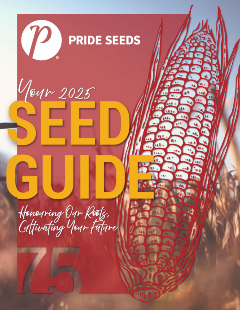___________________________________________________________________________________________________________________________________________

2024-2025 PRIDE Seeds Product GuideYou can find all of our products on the website, including supporting performance data and create your own personalized guide called My Guide. You can also download the digital version of our printed product guide which includes product comparison charts. |
Corn Crop Growth and Development
The most critical period in the corn plant’s life is the first 28 days. This period sets the plant up for overall success and to reach its maximum yield potential. For this reason, it is important to understand the basic growth habits and what the plant should look like above and below the soil. When scouting a newly planted cornfield here are the four fundamental growth modules that take place from planting through day 28 of a corn plant’s life.
MODULE 1 - THE SEMINAL ROOT SYSTEM
As the kernel germinates the first root that extends out from the tip end of the seed is called the radicle. A healthy radicle will extend approx. 2-4 inches down & away from the seed (into the soil) & should resemble a “furry foxtail.” The radicle is followed by other seed roots that shoot out the opposite direction, these are known as the lateral seminal roots. Together, all of the seed roots make up the seminal root system that feeds the plant for the next 3-4 weeks, until the first nodal root system is established.

The seminal root system always grows downward because of gravity. At this time, the radicle is extremely vulnerable to fertilizer burn & insect feeding.
MODULE 2 - THE COLEOPTILE
The coleoptile (or spike) is what pushes up through the soil surface. This process generally takes place within 7 days of planting but requires ~125 GDUs. Extremely warm soil, PGRs, or starter fertilizer can speed up this process. Inside the coleoptile are the first sets of corn leaves waiting to emerge. As the coleoptile pushes through the soil surface & meets sunlight, it opens / splits, allowing the first set of leaves to emerge.

There are 2 key vulnerabilities at this point — crusted soils & chemical injury. Crusted soils can keep the coleoptile from breaking through the surface. Chemical injury can keep the spike from splitting correctly. Both disruptions can result in corn leafing out under the ground.
MODULE 3 - THE MESOCOTYL
The mesocotyl, sometimes referred to as the “umbilical cord,” is the tubular, white, stem-like tissue connecting the seed & the coleoptile. It is very important to the plant’s health because it is the link between the seed & the crown.

Any disruptions to the mesocotyl during this 3-4 week period, like insect chewing or seedling disease, can be detrimental to the plant.
MODULE 4 - THE CROWN
The crown is the area that is referred to as the growing point and where the first set of nodal roots are developed. The crown will always form approximately 2 cm (3/4”) below the soil surface. That’s why between 3.8-5 cm (1.5-2”) are desirable planting depths. Once the nodal root system is established, the plant weans itself from the seed and continues to grow in a self-sufficient manner. At this point, the role of the mesocotyl, seed, and seminal root system is finished. If a small seedling gets held back for any reason, the survival rate depends on good nodal root system establishment.

If planting depth is shallow (2 cm / 3/4” or less) the mesocotyl will have no elongation & nodal root development will take place at or near the soil surface.
This content is intended to be a quick and easy reference when evaluating new corn seedlings.
Reach out to your local PRIDE Seeds Agronomist if you have any questions.
THE PRIDE SEEDS ADVANTAGE
Farming is one of the most demanding industries in the world, subject to a variety of factors such as time, weather, and global pressures. You know this every time you look out the window and think about the field in front of you. Growers and dealers deserve an advantage: The PRIDE Seed Advantage.
LEARN MORETHE PRIDE SEEDS ADVANTAGE
Every year PRIDE Seeds works hard to produce leading-edge products that enable success where it matters most, on your farm. Our dedicated team strives to provide sales expertise, agronomy support, quality production, and service tailored to meet your needs.
LEARN MORE
-7.png?sfvrsn=87920db3_3)

Leave a commentOrder by
Newest on top Oldest on top